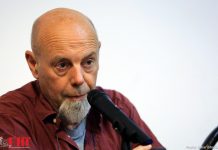ARTNEWSPRESS: A period movie with a twist, The Last Tree is the coming-of-age story of a boy struggling to find his identity in both the English countryside in which he’s raised and the Nigerian shantytown of his birth
Shola Amoo sits outside a cafe on a sun-blazed afternoon, a man with something up his sleeve. Imagine a British period movie and what you picture may not look like The Last Tree, the film he has written and directed. But that is what it is: set in the early 00s, an era whose signifiers are as precise as steam trains or bonnets – a CD Walkman and a tiny Nokia used to make calls, in a story set in rural Lincolnshire, south London and Lagos, Nigeria.
“I’m not sure a film like this has been a thing in British cinema before,” Amoo says, genial and self-contained. “But it’s a thing now.”
As a film-maker of colour producing a portrait of black boyhood in three vivid acts, comparisons to Barry Jenkins and Moonlight are inevitable. Yet The Last Tree has a brilliance all its own. The hero is Femi (played first by the young actor Tai Golding, then a fellow newcomer, Sam Adewunmi). We meet him aged 11 in the care of a white foster mother deep in the English countryside, before his Nigerian birth mother reclaims him. Fast forward and he is 16, unravelling in London. Lagos awaits.
The film is billed as semi-autobiographical. As a child, Amoo was also fostered by a white carer in a “monochromatic” small town. Then came reunion with his Nigerian family and a new start in south London. “There was a lot of dissonance for a kid,” he says. “Leaving somewhere you thought was home to go to this place that is apparently your real home, and then there’s this whole other place everyone else knows and you don’t.”
Now in his 30s, Amoo still lives in the stretch of London where he spent his later childhood. Shooting in Elephant and Castle, he rarely had to walk more than 10 minutes from his flat. One location was outside his old secondary school, Geoffrey Chaucer. “It could feel like therapy.” He calls The Last Tree a search for identity. Much of his own life, he says, might be described the same way.
Yet, not so fast. Semi-autobiographical, he insists, means exactly that. The film is at once his story and not. Details diverge – he was not brought up in a single-parent household, for instance, but within a “family family” – while Femi has his own narrative arc. Some of that is down to Amoo ringfencing his privacy. “It’s important I hold some things back.” He also wants to represent the stories of other people of colour he has met who were similarly fostered. Many, he says, have been left traumatised.
Amoo was a bright and inquisitive child. He read the Odyssey and Malcolm X before he was out of his teens. At university, he studied journalism. Required to make a documentary, he made a short film about the stabbing of a friend. Something clicked. “I realised film could hold everything that fascinated me: literature, music, performance.” The issue was logistics. “I graduated broke. So broke! And no contacts. The question was: ‘How do I even do this?’”
One answer involved a scheme for young writers at the Royal Court theatre. Practical experience came via making videos for early grime artists in the days of urban music TV station Channel U. Amoo cracks up laughing. “I’m still convinced that whole operation was a police setup to get young men to hand over testimony.” Eventually, in 2016, he made his first feature, A Moving Image, about gentrification in Brixton. The film made a splash with a daredevil blend of scripted drama and vérité street life.
It was also a blueprint. While Amoo hungered to tell black stories, he wanted to do it “transformatively”. He pulled together a crew with a black cinematographer, editor and composer – rare in British film. On screen, the aim was to upend expectations. “With The Last Tree, I said from the start: ‘OK, this is a coming-of-age that will subvert. Cinematically, politically. All of it.’”
One answer involved a scheme for young writers at the Royal Court theatre. Practical experience came via making videos for early grime artists in the days of urban music TV station Channel U. Amoo cracks up laughing. “I’m still convinced that whole operation was a police setup to get young men to hand over testimony.” Eventually, in 2016, he made his first feature, A Moving Image, about gentrification in Brixton. The film made a splash with a daredevil blend of scripted drama and vérité street life.
It was also a blueprint. While Amoo hungered to tell black stories, he wanted to do it “transformatively”. He pulled together a crew with a black cinematographer, editor and composer – rare in British film. On screen, the aim was to upend expectations. “With The Last Tree, I said from the start: ‘OK, this is a coming-of-age that will subvert. Cinematically, politically. All of it.’”
The Last Tree opens in the Wash, the improbably flat zone of coastal Lincolnshire with which Amoo became besotted while visiting a former girlfriend. The black community in rural eastern England is small. The nearest major town to the shoot, Boston, recorded the UK’s highest leave vote in 2016. Many directors would site it as a hotbed of racism. To Amoo, the more radical choice was an idyll for the young Femi. “No one expects to see a happy black kid in that environment, just living life. But somewhere that remote, a carer can filter out a lot.”
In London, Amoo created a child’s-eye view, a world of noise and dazzle, tower blocks like brutalist spaceships. “I’m bored of films that demonise estates,” he says. “I’ve seen that one-note gritty cliche. Some of the prettiest shots in the film are in the hood.” While crime and violence lurk, the older Femi also experiences young love and everyday rebellion, gawky mates shoplifting mouthwash. “We know young black men are routinely criminalised, but I wanted to let black kids have moments of pure teenage joy that have always been denied them on screen. All the kids I knew stole a bunch of shit from shops and no one had to go to jail!”
But pain does sit at the heart of the film. Femi is anguished by the mismatch of past and present, the fracture in his sense of belonging. Amoo’s own wry smile at the memory of Geoffrey Chaucer – since closed – fades when discussing a school with “80% black kids, the other 20 Asian and Latino,” yet which, he recalls, had only a single black teacher. In a moment when Amoo struggled academically, he was the one who saved the day. “There still aren’t enough black teachers,” Amoo says. “That or they’re not praised enough.”
Growing up in the 00s was an obstacle course of other people’s norms. “There was so much fear among my peers of stepping into what was culturally seen as white territory. I never paid attention.” In The Last Tree, the CD Walkman introduces Femi to the Cure, a detail Amoo did pluck direct from reality. “I never saw them as ‘not for me’. I loved Robert Smith’s energy. It was such a pleasure to reframe them.”
Reframed, too, is Lagos, a city of shantytowns, luxury and 21 million lives in motion. Amoo did not visit Nigeria until he was in his 20s. Now, he does so regularly. But it was filming there, he says, that made him see the connection between his three locations. “My Lagos wasn’t going to be a tourist postcard or poverty porn. The place is complicated. Endless different things at once. Then it hit me – that was just like London, just like Lincolnshire.”
Back in Britain amid the current chaos, Amoo says he feels oddly at peace. “I’m going counterclockwise, right?” But then, the national meltdown involves ideas he has wrestled with for years. “I couldn’t articulate Britishness. It never felt like it was meant for me. I understand London because it’s the city I grew up in. I understand Nigeria because it’s the house I grew up in. Beyond that? I’m working class, but people might say I make films so I must be middle class. I’m black, because that’s how everyone here perceives me. But in Nigeria that is only a starting point.”
If The Last Tree began as a search for identity, Amoo now rephrases the question. “It’s identities. And the answer is in multiple locations.”
https://theguardian.com
Danny Leigh
























